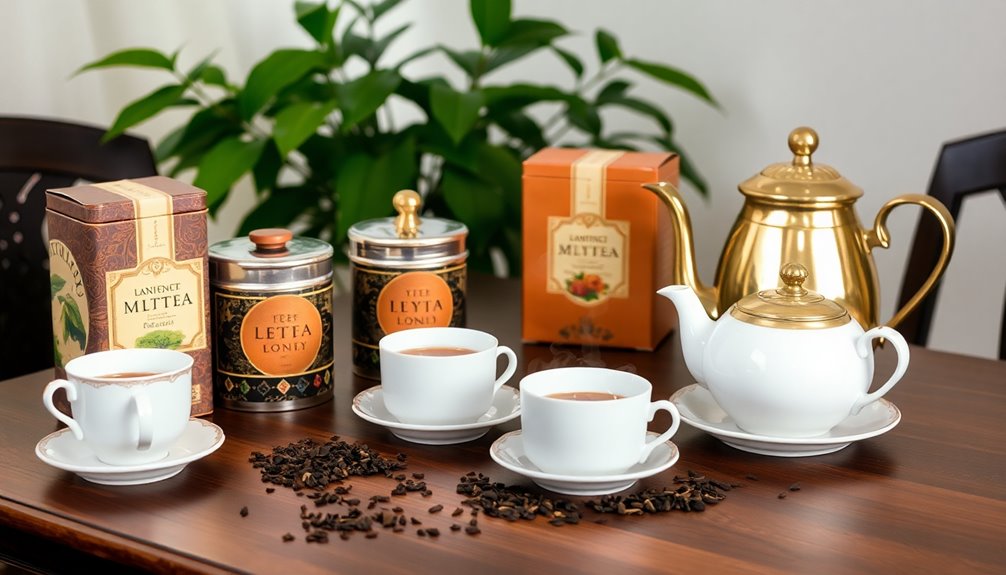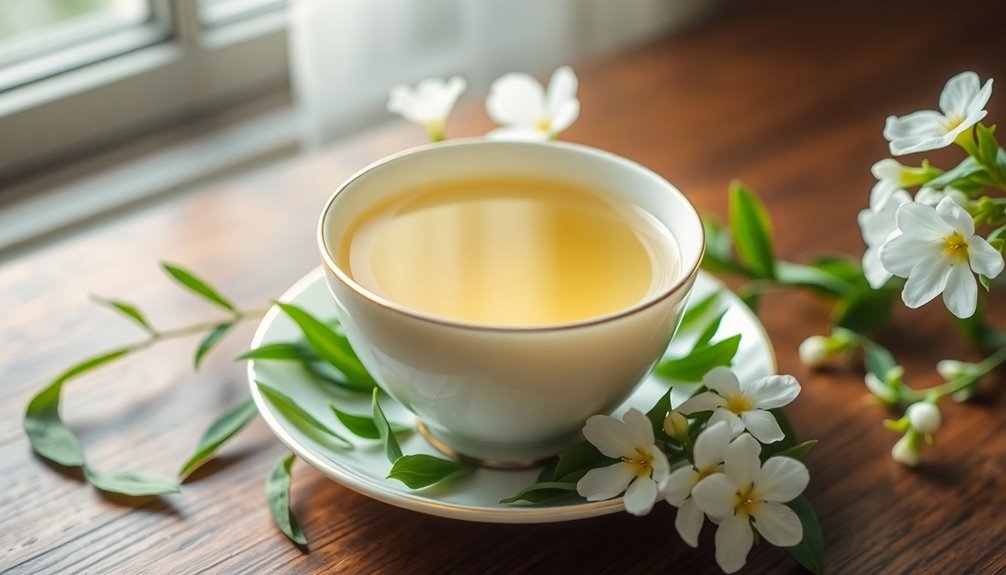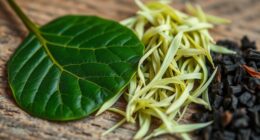Matcha is different from regular green tea mainly because of how it's made, its nutritional benefits, and how you can use it. Matcha comes from whole tea leaves that are ground into a fine powder, while regular green tea is made by steeping leaves. This process allows matcha to have 137 times more antioxidants. You can use matcha in smoothies, baked goods, and drinks, making it more versatile. Plus, the way you prepare matcha—whisking the powder into water—creates a unique frothy drink. There's so much more to discover about matcha and its amazing qualities!
Key Takeaways
- Matcha is made from whole ground leaves, while regular green tea is brewed from steeped leaves, affecting nutrient retention.
- Matcha contains 137 times more antioxidants than brewed green tea, offering significantly higher health benefits.
- The caffeine content in matcha is much higher, providing an energy boost compared to regular green tea.
- Matcha boasts a rich umami flavor and vibrant color, making it versatile for culinary applications beyond beverages.
- Preparation of matcha involves whisking powder into water, while green tea requires steeping, leading to different taste and experience.
Introduction
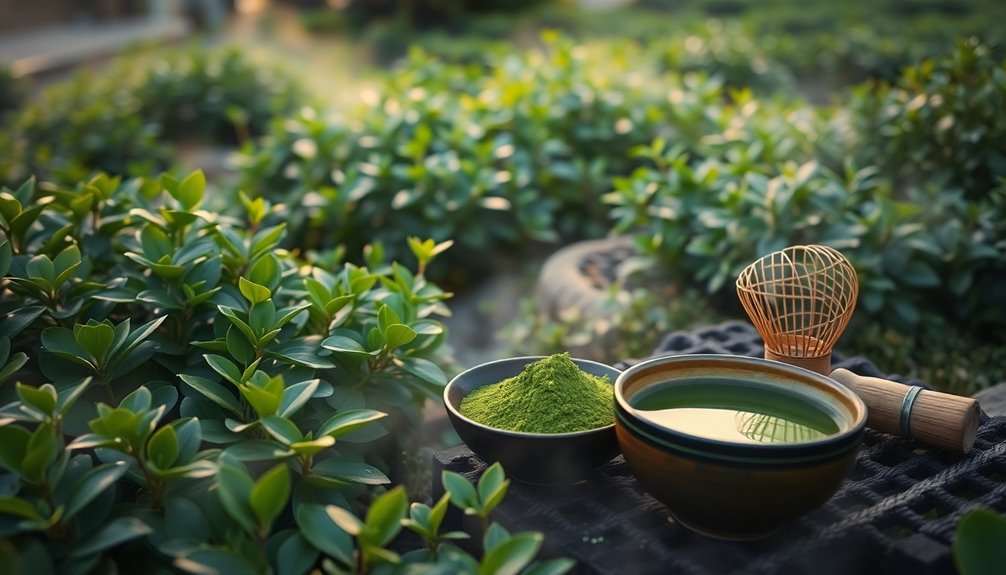
When it comes to tea, many people often wonder about the differences between matcha and regular green tea. Both of these popular beverages come from the same tea plants, but they differ in preparation methods and health benefits.
Matcha is made from the whole leaf, which is ground into a fine powder. This means you get more nutrients and antioxidants with matcha compared to steeped green tea leaves.
One exciting aspect of matcha is its vibrant green color, a result of shading the tea plants for three weeks before harvest. This process boosts chlorophyll levels, giving matcha its unique look and enhancing its antioxidant content.
When you compare matcha vs regular green tea, you'll notice matcha has significantly higher caffeine content, about 280 mg per serving, while regular green tea has only 15-48 mg.
Additionally, matcha has more L-Theanine, which promotes relaxation, making it a great choice for tea consumption.
Culinary Uses of Matcha
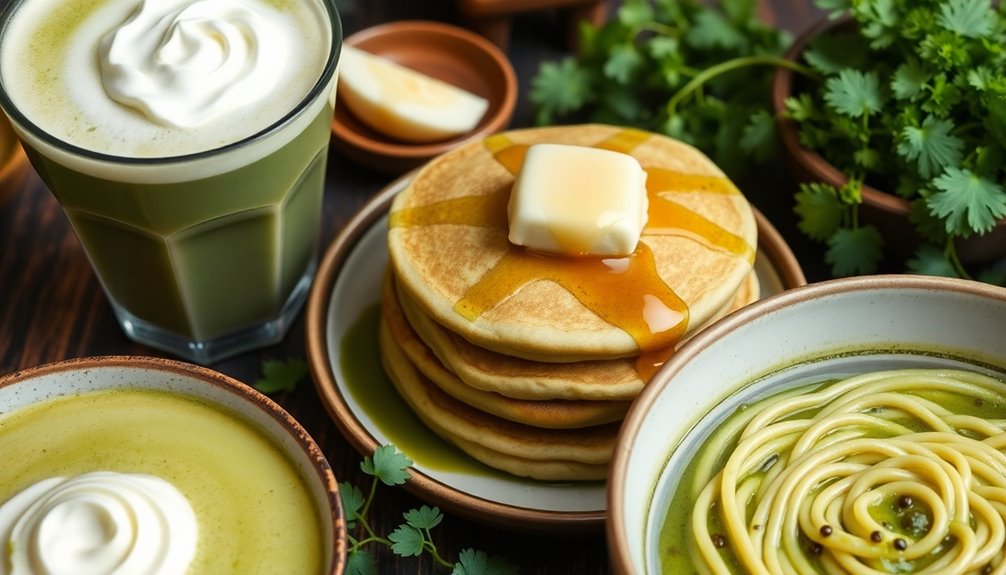
Matcha's unique powdered form opens up a world of culinary possibilities that regular green tea simply can't match. You can easily incorporate matcha into a variety of recipes, from smoothies to baked goods, enhancing both flavor and nutrition.
Its vibrant green color makes it a fantastic natural food coloring for desserts, giving your treats an appealing look while adding health benefits.
Matcha's rich umami flavor also shines in savory dishes. You can use it in salad dressings or marinades, adding a creative twist to your meals.
This versatile ingredient can be whisked into hot or iced beverages, so whether you're sipping a warm latte or a refreshing summer drink, matcha fits right in.
Unlike regular green tea, which is mainly enjoyed as a brewed beverage, matcha allows for a broader range of culinary uses. You can experiment with its unique flavor profile in countless recipes, making it a fun ingredient to explore in your kitchen.
Nutrient Density Comparison
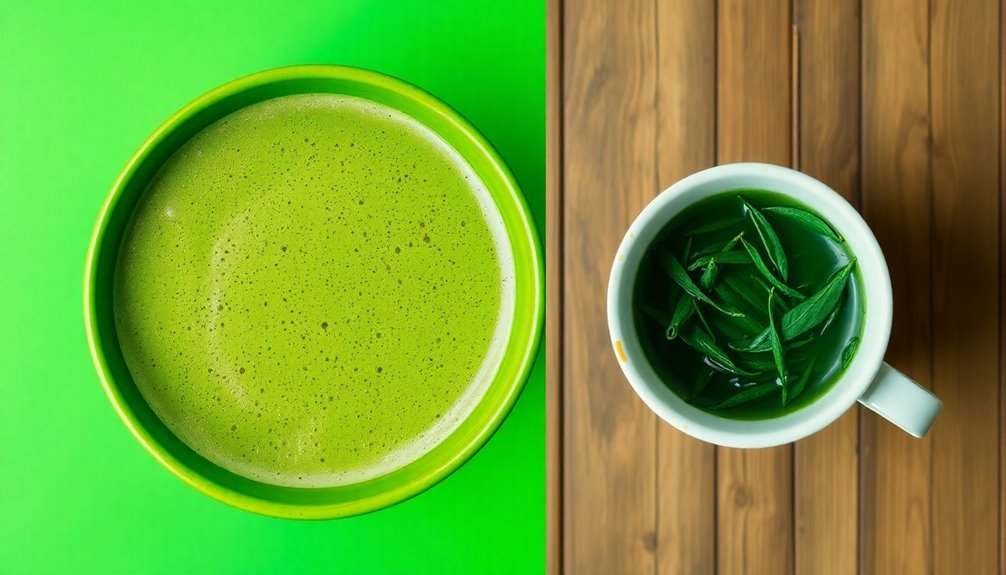
In today's health-conscious world, understanding the nutrient density of matcha compared to regular green tea is essential for making informed choices. Matcha is a powerhouse of nutrients, offering about 137 times more antioxidants than brewed green tea. This means when you sip matcha, you're getting a concentrated source of health benefits. Just one cup of matcha packs the nutrient content of about 10 cups of regular green tea!
Another notable difference is in L-Theanine, an amino acid that promotes relaxation and focus. Matcha provides around 45 mg of L-Theanine per serving, while green tea has only about 3 mg.
Plus, matcha has a caffeine content of roughly 280 mg, giving you a solid energy boost, unlike green tea, which has only 15-48 mg.
The secret to matcha's rich nutrient density lies in its whole leaf, powdered form. This means you consume the entire leaf, while green tea mainly releases water-soluble compounds during steeping.
Preparation Ritual Differences
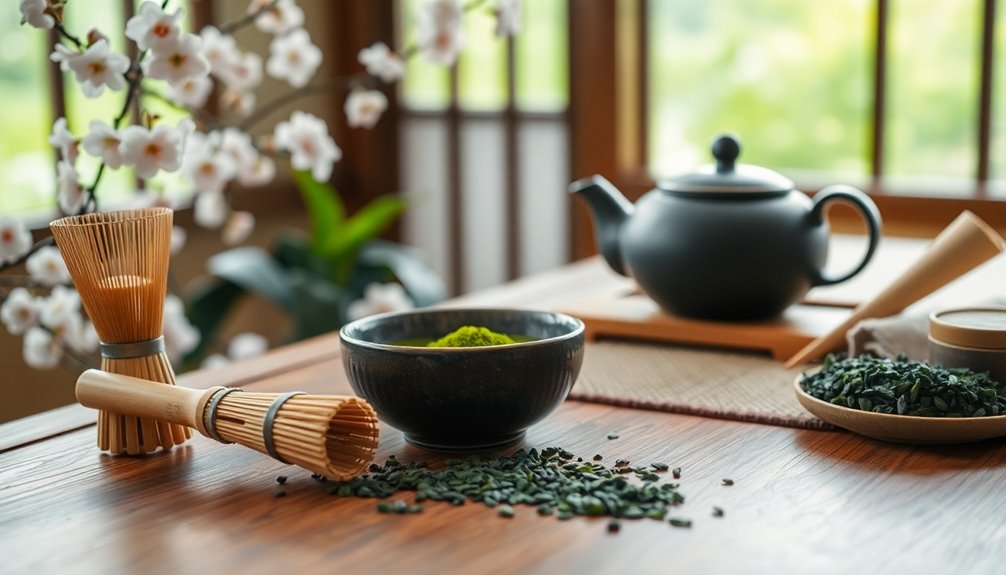
There's a distinct contrast in the preparation rituals of matcha and regular green tea that enhances the overall experience of each beverage. When you make matcha, you whisk a fine powder directly into hot water. This creates a frothy drink that's visually appealing and fun to prepare!
In contrast, green tea requires steeping the leaves for several minutes. This steep time allows the flavors to infuse but doesn't capture the full leaf's benefits.
The ceremonial aspect of matcha preparation adds to its charm. You typically use a chasen, a bamboo whisk, and a chawan, a special tea bowl, to create an authentic experience. By consuming the entire leaf, matcha maximizes your nutrient intake compared to regular green tea, where you only extract the water-soluble components from the leaves.
Matcha's versatility also makes it exciting! You can enjoy it in lattes, smoothies, or even baked goods, while green tea is mainly served as a brewed beverage.
The quality of matcha matters too, as ceremonial grade matcha is favored for drinking. This attention to detail makes the preparation ritual for matcha a delightful experience you won't want to miss!
Health Claims Scrutiny

While both matcha and regular green tea offer health benefits, the claims surrounding matcha often demand closer examination. You might hear that matcha contains up to 137 times more antioxidants than brewed green tea. This is mainly because you're consuming the whole leaf, which boosts its nutrient levels. The health benefits of matcha, like improved cognitive function and reduced oxidative stress, come from these potent antioxidants.
Another point to consider is matcha's caffeine content. It can pack a punch with about 280 mg per serving, much higher than regular green tea's 15-48 mg. This can give you a significant energy boost, but it's important to know how your body reacts to caffeine.
Plus, matcha offers more L-Theanine, an amino acid that promotes relaxation without making you sleepy. You'll get 45 mg per serving compared to just 3 mg in green tea.
Both types of tea can support heart health and metabolism, but matcha's concentrated green profile may enhance these benefits even more.
Practical Applications
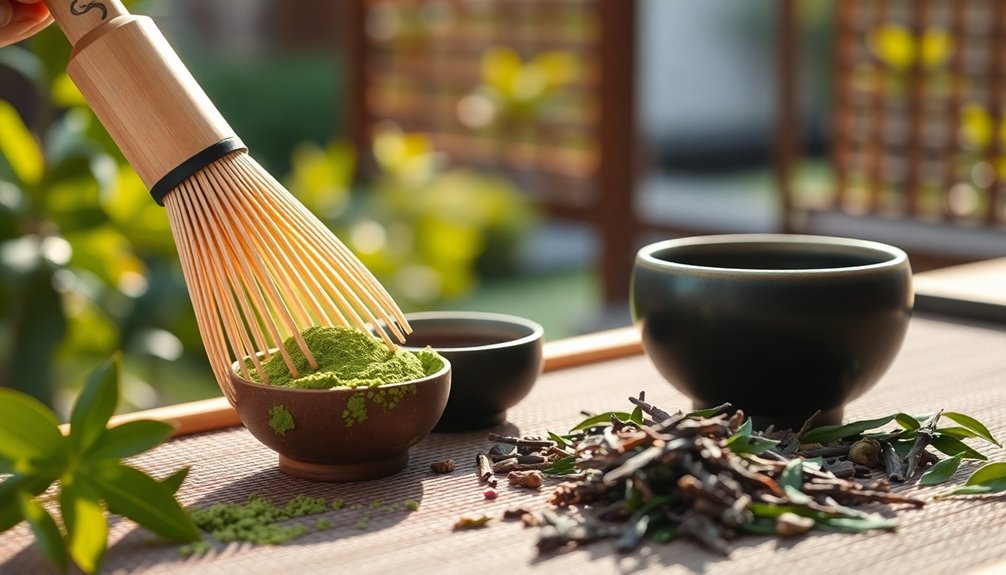
Matcha offers a versatile culinary experience that goes beyond traditional tea brewing. Unlike regular green tea, which is primarily enjoyed as a brewed beverage, matcha tea comes in a powdered form, allowing you to mix it into smoothies, baked goods, and lattes.
When you're preparing matcha, you whisk the powder into hot water, creating a frothy texture that makes drinking it a delight.
One serving of matcha gives you the nutritional equivalent of up to ten cups of regular green tea, maximizing the benefits of green tea in one go. Its unique flavor profile is more concentrated than that of green tea leaves, often making it a great choice for sweetening or pairing with milk.
Plus, the higher levels of L-theanine in matcha provide a calming effect, perfect for enhancing focus and relaxation.
When you're experimenting with different types of tea, remember that the water temperature plays a crucial role in extracting the best flavors.
Frequently Asked Questions
Is Matcha Healthier Than Regular Green Tea?
Yes, matcha's higher antioxidant levels, caffeine content, and L-Theanine make it healthier than regular green tea. You'll enjoy enhanced focus and energy while benefiting from more nutrients, supporting your overall well-being and metabolic health.
Is Matcha Just Powdered Green Tea?
No, matcha isn't just powdered green tea. It's made from specially grown leaves, using the entire leaf for a richer flavor and higher nutrient content, unlike regular green tea, which only steeps the leaves.
Why Does Matcha Taste Different From Green Tea?
When you taste matcha, you'll notice its richer, sweeter flavor and frothy texture. This comes from shading during growth, higher tannin levels, and the powdered form, which all contribute to its unique taste compared to green tea.
Is Matcha Anti-Inflammatory?
Yes, matcha is anti-inflammatory. Its high catechin content, particularly EGCG, helps reduce inflammation in your body. Regularly enjoying matcha can lower inflammatory markers and promote a calm, balanced immune response.
Conclusion
In summary, matcha stands out from regular green tea in many exciting ways. Its unique culinary uses, higher nutrient density, and distinct preparation make it a special choice. While health claims are worth exploring, remember to enjoy matcha in moderation. Whether you're sipping it in a latte or using it in recipes, you're adding a boost of flavor and nutrients to your day. So, why not give matcha a try and discover its delicious benefits for yourself?




